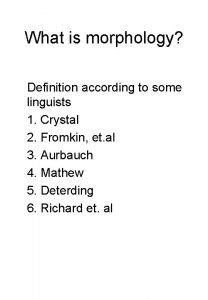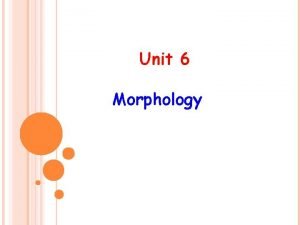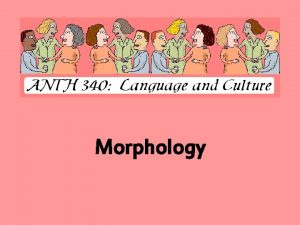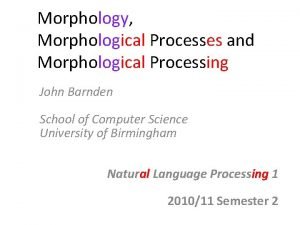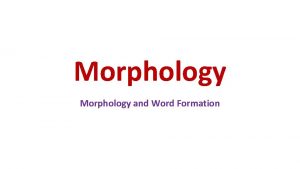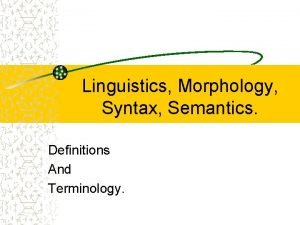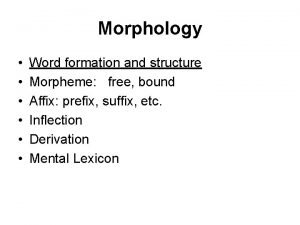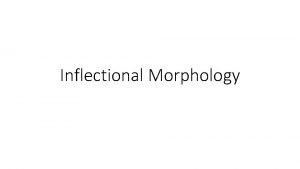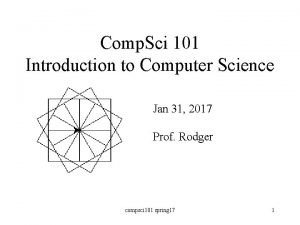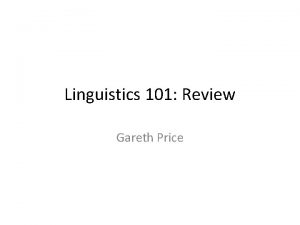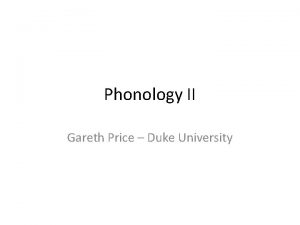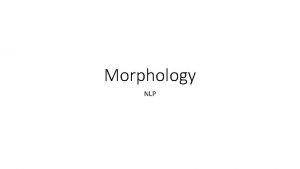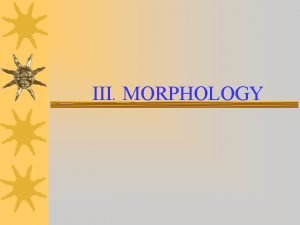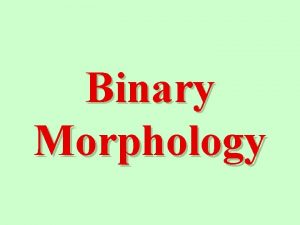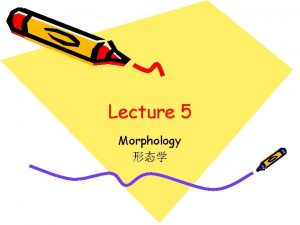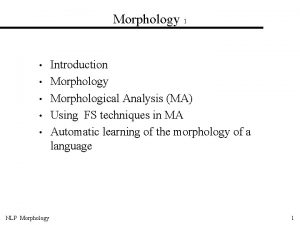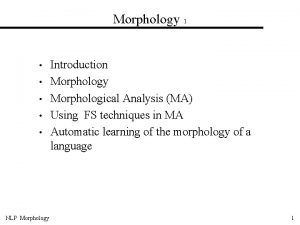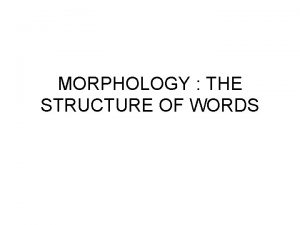Morphology I Linguistics 101 Gareth Price Duke University















- Slides: 15

Morphology I Linguistics 101 Gareth Price Duke University

Morphology • • Morph + ology Morphe = shape/form Ology = study, science of Study of the formation (v, n) of words?

• How many words in the English language? • Accidental gaps: words which follow the phonological rules of a language, but which don’t actually exist • How many words do you know? • Not easy to answer – linguists rarely agree. • College educated: 10, 000 to 60, 000 • Why is it difficult to know? • Mental lexicon

• • • • plinkling grimoulously klints twongier pendy thrustling stangliness centomer splimly centome stribble plinkleable decentome plinkler stribbling • • • • klintish liggeted pendierr pentful glosselstrop thrustle stromp grimulous acturously ponymous brimney stang parples stribbled klint • • • • unplinkleableness twength parple sloke pendiest fustered twong restribble sloken klintly acturous stangs strissed twongest liggets

Word Classes • Lexical Words – Nouns / Adjectives / Verbs / Adverbs • ‘Open class’ • Semantic content • Easily added to and modified • Most words are lexical words • Function Words – Determiners (a, the, an) – Pronouns (I, you, she, his, theirs) – Conjunctions (and, but) – Prepositions (to, in, without, for) – Intensifiers (very, too) – Auxiliary/Modal verbs (must, may, will) • ‘Closed class’ • Grammatical content • Tend not to be easily changed or added to

Morphemes • Smallest unit of words which have: • semantic content (meaning) • grammaticality (function) • un (semantic) + build (semantic) • magic (semantic) + ician (grammaticality) • cat (semantic) + s (grammaticality) • cat = four legged, furry, feline • s = plural

Morphemes One Two Three More than three a and dog-s write-r please pleas-ing red-der do un-do-able-ness caliber calibr-ate re-calibr-at-ion Words with one morpheme: simple “ two or more morphemes: complex

Free vs. Bound Morphemes • birds • bird / *-s • undo do / *un • • Hare (Athapaskan) *fi ‘head’ sefi ‘my head’ *be ‘belly’ nebe ‘your belly’ *dze ‘heart’ ? edze ‘someone’s heart / a heart’ Thai: Boon thaan khaaw leew Boon eat rice – past tense marker ‘Boon ate rice’

Allomorphs • • • a / an pots pigs bridges Turkish: lokanta ‘a restaurant’ – lokantada ‘in/at a restaurant’ kapi ‘a door’ – kapida ‘in/at a door’ kitap ‘a book’ – kitapta ‘in/at a book’ koltuk ‘a chair’ – koltukta ‘in/at a chair’ taraf ‘a side’ ? randevu ‘an appointment’ ? • Note: the morphology of a word is the study of its shape and meaning – but shape can be writing or sound

Roots, Stems and Affixes • • • Root + affix = complex word Black + en = blacken (root + suffix) adjective + suffix = verb blacken + ed = blackened verb + suffix = past tense verb black = root and stem for blacken black = root & blacken = stem for blackened unblackened = prefix + root + suffix but. . . unhappiness? un + happy + ness? un + knowledge? / un + ability?

Infixes Tagalog: takbuh ‘run’ – t-um-akbuh ‘ran’ lakad ‘walk’ – l-um-akad ‘walked’ Insertion of an affix within a base: in this case before the first vowel. • Arabic: • katab ‘write’ kutib ‘have been written’ aktub ‘be writing’ uktab ‘being written’ • Insertion of two vowels sounds among the three consonants which comprise the root • •

Internal Change • Changes in an internal non-morphemic segment to illustrate grammatical contrast. • sing – sang – sung • sink – sank – sunk • foot – feet • goose – geese • In English, there is a vowel change (ablaut) to mark past tense. • Umlaut: ‘fronting’ of vowel in response to front vowel in following syllable • go: s go: iz gi: s • Not infixing, however, as not changing the base *gs or *sng or *ft • no such morpheme as ‘oo’/‘ee’ or ‘i’/‘a’

Suppletion • • • Can be completely different morph (sound): French: avoir ‘to have’ eu ‘had’ Spanish: ir ‘to go’ fue ‘(he) went’ German: ist ‘is’ sind ‘are’ English: to be/is/are/we/were / to go/went

Suppletion or Internal Change? • But. . . think / thought seek / sought catch / caught • Probably extreme forms of internal change – sometimes called partial suppletion

Summary. . . • How many words in a language? How many do you know?
 Gareth price duke
Gareth price duke Morphemes examples list
Morphemes examples list Ano ang ibig sabihin ng pagkabigo ng pamilihan
Ano ang ibig sabihin ng pagkabigo ng pamilihan Traditional linguistics and modern linguistics
Traditional linguistics and modern linguistics Applied linguistics
Applied linguistics Inflectional morpheme
Inflectional morpheme Lexical morphemes examples
Lexical morphemes examples Analysis of word structure
Analysis of word structure Morphology process
Morphology process Morphology linguistics definition
Morphology linguistics definition Nosebleed
Nosebleed Morphology definition linguistics
Morphology definition linguistics Amaze word formation
Amaze word formation Morphology meaning
Morphology meaning 8 inflectional morphemes
8 inflectional morphemes Compsci 101 duke
Compsci 101 duke





